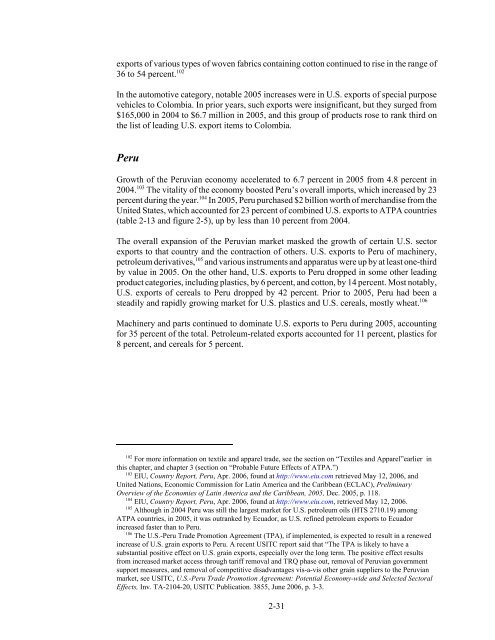The Impact of the Andean Trade Preference Act Twelfth ... - USITC
The Impact of the Andean Trade Preference Act Twelfth ... - USITC
The Impact of the Andean Trade Preference Act Twelfth ... - USITC
- No tags were found...
You also want an ePaper? Increase the reach of your titles
YUMPU automatically turns print PDFs into web optimized ePapers that Google loves.
exports <strong>of</strong> various types <strong>of</strong> woven fabrics containing cotton continued to rise in <strong>the</strong> range <strong>of</strong>36 to 54 percent. 102In <strong>the</strong> automotive category, notable 2005 increases were in U.S. exports <strong>of</strong> special purposevehicles to Colombia. In prior years, such exports were insignificant, but <strong>the</strong>y surged from$165,000 in 2004 to $6.7 million in 2005, and this group <strong>of</strong> products rose to rank third on<strong>the</strong> list <strong>of</strong> leading U.S. export items to Colombia.PeruGrowth <strong>of</strong> <strong>the</strong> Peruvian economy accelerated to 6.7 percent in 2005 from 4.8 percent in2004. 103 <strong>The</strong> vitality <strong>of</strong> <strong>the</strong> economy boosted Peru’s overall imports, which increased by 23percent during <strong>the</strong> year. 104 In 2005, Peru purchased $2 billion worth <strong>of</strong> merchandise from <strong>the</strong>United States, which accounted for 23 percent <strong>of</strong> combined U.S. exports to ATPA countries(table 2-13 and figure 2-5), up by less than 10 percent from 2004.<strong>The</strong> overall expansion <strong>of</strong> <strong>the</strong> Peruvian market masked <strong>the</strong> growth <strong>of</strong> certain U.S. sectorexports to that country and <strong>the</strong> contraction <strong>of</strong> o<strong>the</strong>rs. U.S. exports to Peru <strong>of</strong> machinery,petroleum derivatives, 105 and various instruments and apparatus were up by at least one-thirdby value in 2005. On <strong>the</strong> o<strong>the</strong>r hand, U.S. exports to Peru dropped in some o<strong>the</strong>r leadingproduct categories, including plastics, by 6 percent, and cotton, by 14 percent. Most notably,U.S. exports <strong>of</strong> cereals to Peru dropped by 42 percent. Prior to 2005, Peru had been asteadily and rapidly growing market for U.S. plastics and U.S. cereals, mostly wheat. 106Machinery and parts continued to dominate U.S. exports to Peru during 2005, accountingfor 35 percent <strong>of</strong> <strong>the</strong> total. Petroleum-related exports accounted for 11 percent, plastics for8 percent, and cereals for 5 percent.102 For more information on textile and apparel trade, see <strong>the</strong> section on “Textiles and Apparel”earlier inthis chapter, and chapter 3 (section on “Probable Future Effects <strong>of</strong> ATPA.”)103 EIU, Country Report, Peru, Apr. 2006, found at http://www.eiu.com retrieved May 12, 2006, andUnited Nations, Economic Commission for Latin America and <strong>the</strong> Caribbean (ECLAC), PreliminaryOverview <strong>of</strong> <strong>the</strong> Economies <strong>of</strong> Latin America and <strong>the</strong> Caribbean, 2005, Dec. 2005, p. 118.104EIU, Country Report, Peru, Apr. 2006, found at http://www.eiu.com, retrieved May 12, 2006.105 Although in 2004 Peru was still <strong>the</strong> largest market for U.S. petroleum oils (HTS 2710.19) amongATPA countries, in 2005, it was outranked by Ecuador, as U.S. refined petroleum exports to Ecuadorincreased faster than to Peru.106<strong>The</strong> U.S.-Peru <strong>Trade</strong> Promotion Agreement (TPA), if implemented, is expected to result in a renewedincrease <strong>of</strong> U.S. grain exports to Peru. A recent <strong>USITC</strong> report said that “<strong>The</strong> TPA is likely to have asubstantial positive effect on U.S. grain exports, especially over <strong>the</strong> long term. <strong>The</strong> positive effect resultsfrom increased market access through tariff removal and TRQ phase out, removal <strong>of</strong> Peruvian governmentsupport measures, and removal <strong>of</strong> competitive disadvantages vis-a-vis o<strong>the</strong>r grain suppliers to <strong>the</strong> Peruvianmarket, see <strong>USITC</strong>, U.S.-Peru <strong>Trade</strong> Promotion Agreement: Potential Economy-wide and Selected SectoralEffects, Inv. TA-2104-20, <strong>USITC</strong> Publication. 3855, June 2006, p. 3-3.2-31
















